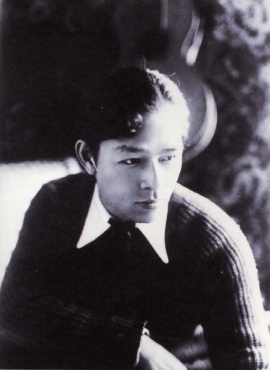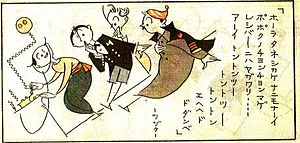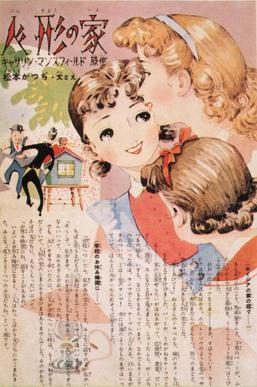Katsuji Matsumoto facts for kids
Quick facts for kids Katsuji Matsumoto |
|
|---|---|

Katsuji Matsumoto in an undated photograph
|
|
| Born | July 25, 1904 Kobe, Hyōgo Prefecture, Japan |
| Died | May 13, 1986 (aged 81) Izu, Shizuoka, Japan |
| Nationality | Japanese |
| Area(s) | Illustrator, comics creator, designer |
|
Notable works
|
Kurukuru Kurumi-chan The Mysterious Clover |
Katsuji Matsumoto (松本かつぢ, Matsumoto Katsuji, 1904–1986) was a Japanese illustrator and shōjo manga (girls' comics) artist. He is known for his early manga The Mysterious Clover (1934). But he is most famous for his girls' manga series Kurukuru Kurumi-chan, which was published from 1938 to 1940, and again from 1949 to 1954.
Matsumoto's illustrations were very popular from the 1930s to the 1950s. He drew pictures for many popular girls' novels by famous authors like Yasunari Kawabata. He also illustrated children's books and designed products for babies and young girls. Today, his children manage the Gallery Katsuji Matsumoto in Tokyo, which shows his work.
Contents
Early Life and Artistic Start
Matsumoto was born in Kobe, Japan, in 1904. When he was eight, his family moved to Tokyo. At 13, he started attending Rikkyō Middle School.
When he was 17, a teacher helped him begin drawing illustrations for a magazine called Shinseinen (新青年, "New Youth"). At 18, Matsumoto left Rikkyō and went to the Kawabata ga gakkō (川端画学校, "Kawabata Art School"). During this time, he drew for magazines like Shōjo sekai (少女世界, "Girls' World") and Shōnen sekai (少年世界, "Boys' World"). He was inspired by another illustrator, Kōji Fukiya, to focus on art for girls' media.
After a big earthquake in 1923 damaged Tokyo's publishing industry, Matsumoto decided to travel. He went to Shanghai, hoping to eventually reach Paris. In Shanghai, he earned money by drawing for the Shanhai nichinichi shinbun (上海日日新聞, "Shanghai Daily Newspaper"). When he turned 20, he had to return to Japan.
Early Career and Family Life
Matsumoto's first regular job was with the magazine Shōjo Gahō (少女画報, "Girls' Illustrated"). He worked there from 1928 to 1938. He started creating manga in Shōjo Gahō with a series about a lively Chinese girl named Poku-chan. These stories were published between 1930 and 1934. The Poku-chan comics had a stylish, almost abstract, Art Deco look.
Matsumoto could draw in many different styles, from realistic to nearly abstract. His art always had clean, almost geometric lines and a modern feel. While he illustrated many dramatic girls' novels, his style was best for cheerful, playful, or funny works. In 1935, Matsumoto began working for Shōjo no tomo (少女の友, "Girls' Friend"), which became his main magazine. Its modern and stylish image was perfect for his art.
In 1932, Matsumoto married Ayako Nimori. They had seven children together.
Major Works
The Mysterious Clover
In 1934, Matsumoto drew his first full manga, a 16-page story called Nazo no kurōbaa (?(なぞ)のクローバー, "The Mysterious Clover"). It was given as a special gift with the April issue of Shōjo no tomo. This story was like The Scarlet Pimpernel or Zorro. The main character is a young girl who protects poor farmers from cruel nobles. This manga was special because it used different camera angles, like views from above, and varied panel sizes. For many years, manga experts didn't pay much attention to The Mysterious Clover. But it was shown at an art exhibition in 2006 and became recognized as an important early manga.
Kurukuru Kurumi-chan
Matsumoto's most famous work is his manga Kurukuru Kurumi-chan (くるくるクルミちゃん). The title means "Spinning Little Kurumi." It was published in Shōjo no tomo from January 1938 to December 1940. The story followed the daily adventures of a little girl named Kurumi (クルミ, meaning "walnut"). Each episode was a short, self-contained story, usually four pages long. The comic mostly showed everyday life, with a touch of growing silliness.
When the series first started, Kurumi-chan looked like she was about nine or ten years old. Over the years, her look changed. By the 1950s, she became a very stylized character, much shorter and with an unknown age. The comic was brought back after World War II in a magazine called Shōjo ("Girl"). It ran from November 1949 to February 1954 under the title Kurumi-chan.
Book Illustrations
While working on Kurukuru Kurumi-chan, Matsumoto also continued to create other illustrations. He drew both color and black-and-white pictures. He also illustrated many girls' fiction stories and poems. Matsumoto was one of the most popular and important illustrators for girls' media. He remained popular through the early 1950s. He worked with famous Japanese authors and poets. He also adapted works by non-Japanese authors, like Katherine Mansfield's short story The Doll's House, into a special type of illustrated story called emonogatari (絵物語, "picture stories").
Matsumoto had a wide range of drawing styles. But his characters always looked smart and cheerful, never sad or overly sweet. Other popular illustrators of his time had different strengths. For example, Jun'ichi Nakahara drew stylish girls, but his work wasn't usually funny. Matsumoto's unique style made him stand out.
Children's Books and Baby Products
In 1955, Matsumoto stopped drawing manga. He continued to do illustrations, but his focus shifted. He started creating very stylized and cute characters, similar to the later Kurumi-chan. His new audience became toddlers and young mothers. He illustrated many new children's books and also classics. These included Little Red Riding Hood (1955) and Andrew Lang's Blue Fairy Book (1959). He also illustrated other collections of classic Japanese and European fairy tales.
In 1960, Matsumoto started Katsu Productions. This company focused on illustrations for babies and toddlers and designing baby products. These products became incredibly popular. One blogger said that Matsumoto's baby goods were "everywhere" when they were a child. His designs for the company "Sanshin. Inc." were very well-known. It's even thought that the company changed its name to Combi in 1961 because of the popularity of two baby characters, "Haamu" and "Monii," that Matsumoto created for their products.
Later Years and Legacy
In 1971, when he was in his late 60s, Matsumoto built an art studio called "Chijunbō" (稚筍房, "Young Bamboo Shoot Studio") on the Izu Peninsula. Here, he changed his creative focus from modern art to traditional art. He used the local bamboo to design toys and objects. Local farmers could easily make these to sell as souvenirs. For this work, Matsumoto received an award from the Shizuoka Prefectural government. Even though these works seemed different from his usual modern style, Matsumoto had always loved traditional Japanese and Korean art and furniture. His art, whether modern or traditional, always showed a love for things that were refined, simple, elegant, and natural.
Katsuji Matsumoto passed away in 1986 at the age of 81.
Matsumoto's children, including Ki Nimori, Ikki Matsumoto, Rumi O'Brien, Motoi Matsumoto, Ken Matsumoto, Meiko Matsumoto, and Michie Utsuhara, continue his legacy. Two successful female shōjo manga artists, Toshiko Ueda and Setsuko Tamura, were once his students. Matsumoto's youngest child, Michie, along with her siblings and Matsumoto's grandchildren, manages the Gallery Katsuji Matsumoto. This gallery will soon be renamed the Katsuji Matsumoto Archives. They also run the official Katsuji Matsumoto website: https://archive.is/20110713140434/http://katsudi.com/katsudiinfo1.html and an on-line shop. Michie also writes a blog called "Kurumi-chan nikki (クルミちゃん日記, "Kurumi-chan Diary")." The gallery is located in Tokyo.
Images for kids








